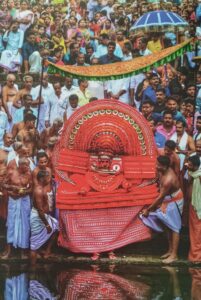BOOK REVIEW: Where divinity overcomes social conventionality
New book by KK Gopalakrishnan chronicles the time and history of theyyam, an ancient indigenous art form from Kerala

 The 2022 film, Kantara, which featured Panjurli theyyam of the Tulu tribe in south India, popularised the ancient art form of theyyam among the masses who were hitherto unaware of it. Many would remember the divine performance of the theyyam artistes in the film on the rendition of Varaha Roopam. While the film broke the regional confinements of the art form and presented it, albeit in a commercial avatar, to a greater audience, theyyam remains an intrinsic part of the tribal culture in Kerala, especially the northern region.
The 2022 film, Kantara, which featured Panjurli theyyam of the Tulu tribe in south India, popularised the ancient art form of theyyam among the masses who were hitherto unaware of it. Many would remember the divine performance of the theyyam artistes in the film on the rendition of Varaha Roopam. While the film broke the regional confinements of the art form and presented it, albeit in a commercial avatar, to a greater audience, theyyam remains an intrinsic part of the tribal culture in Kerala, especially the northern region.
The origin of Theyyam, a “ritual theatre and folk belief”, can be traced way before the Aryanisation of the Dravidian civilisation in the south and the Brahminical influence on the perception of divinity among the indigenous populace. KK Gopalakrishnan, an expert in Kerala art forms, traces this history in his book Theyyam: Indian Folk Ritual Theatre, An Insider’s Vision.
Theyyam is not just an art form. It is a belief system entwined by the intricacies of rituals that rise above conventional social statuses. The art form has its origin in the northern part of Kerala. The theyyam artistes are from economically and socially backward sections. However, the divine performance transgresses social limits and transforms an artiste into a demigod. He no longer remains a menial worker or an outcast but rises to such supremacy that his words are considered deific. Such is the power of theyyam.
Performers too have to undergo years of rigorous training and self-control to achieve such divine status. Each performance is preceded by “a series of opulent rituals”.
“It is not second to any mainstream artistic practice, considering its rich aesthetic potential — right from the venue and attire to theatricals,” writes Gopalakrishnan.
An interesting anecdote about theyyam shrines is that these places of worship traditionally do not have idols. Some shrines would have metal mirrors “as the devotees reach out to see the self-reflected in the mirror and meditate upon it to seek divinity in themselves”.

Besides the rituals and beliefs, theyyam involves painstaking face art and intricate costume designing. Both makeup and costumes use natural and readily available materials. Both have the dominance of the colour red as a symbol of power or shakti. Some theyyams — such as Pottan, Kuntora Chamundi, Gulikan and Etalapuratt Chamundi — also use masks. The costumes are elaborate, and at times, artistes wear exquisite headgear that adds grandeur to the appearance. One cannot separate the process of makeup and costume-making from the divine rituals.
A theyyam performance is also significant as it brings together an entire community, including women and children. While it is the men who perform theyyams, women and children join hands to complete the preparatory phases.
The concept of theyyam considers six kinds of worship — nature, animal, spirit, power, hero and mythological characters. There are also Muslim theyyams, which “shows that our forebearers did not generally view Islam as a mleccha dharma”.
Gopalakrishnan’s tryst with theyyam started at a tender age. With his maternal family one of the important patrons of theyyams, he got the opportunity to study the art form in depth and closely observe the artistes’ transformation during the performances. He has been following the art form for years now and journaled the impact of the changing socio-economic fabric on theyyams and the performers. He shares with readers this vast experience and research in his book. His knowledge of the art form is complemented by the colourful and some of the rare photographs in the book.
Theyyam has long stepped out of the divine ritualistic contours of yesteryears. In fact, this art form has been commercialised so much so that it is also ironically performed on political platforms, which are riddled with opportunistic intentions and divisiveness. Many cultural aficionados, including Gopalakrishnan, and traditional artistes have been opposing such commodification of theyyam. On the other hand, many prominent people are batting for the theyyam to step out of its boundaries so that struggling artistes get a better livelihood and the art form gets wider recognition.
The onslaught of time, migration of the members of the new generation, the rigours of being a performer and the gradual dilution of the true form are making theyyam a rare gem among the numerous indigenous art forms in the country. Gopalakrishnan’s book captures this rarity and documents a journey that needs to be told and must be heard.
Book: Theyyam: Indian Folk Ritual Theatre, An Insider’s Vision; Author: KK Gopalakrishnan; Publisher: Niyogi Books; Pages: 352; Price: Rs 6,000
~ Sunday Monitor





